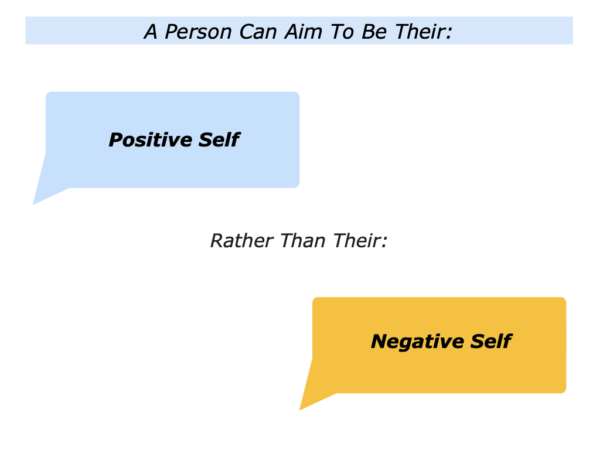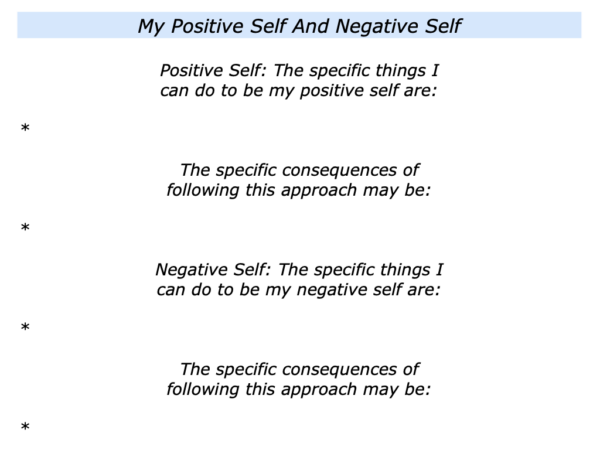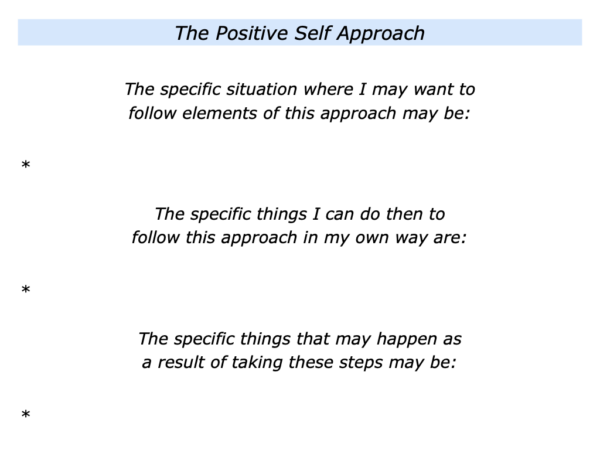
Imagine that a person is feeling down and has asked for your help. One approach is to encourage them to be their positive self.
Many individuals know how to be their positive self. They know it is important to plan ahead, take care of their health, do things they enjoy, spend time with encouraging people and do satisfying work. They know the rewards of developing such healthy habits.
Many individuals also know how to be their negative self. They know how to let things drift, feel sorry for themselves and hope things will change. They know the consequences of developing such unhealthy habits.
Imagine that you want to explore this approach in your own life before helping another person. If you wish, try tackling the exercise on this theme. This invites you to complete the following sentences.

Let’s return to helping a person who is feeling down. One approach is to encourage them: a) to be their positive self; b) to express their positive self; c) to, if appropriate, making a living being their positive self. Let’s explore these themes.
Being Their Positive Self
A person can choose to be their positive self rather than their negative self. They can do the things that are more likely to help themselves to be happy. Some people may object to this approach. They may say:
“This sounds too simple. You don’t always have a choice in these matters.”
People do not always choose what happens to them. But they can choose their attitude to how they respond to such events. They can do things to put themselves into positive rather than negative circles.
If appropriate, you can invite a person to describe: a) the specific things they can do to be their positive self; b) the specific rewards of doing these things. They can then aim:
To translate their ideas into action … To get some quick successes … To maintain the habit of doing these things.
Imagine that the person has begun to explore these ideas. If appropriate, you can help them to move on to the next stage.
Expressing Their Positive Self
There are many ways a person can express their positive self. They may do things they find stimulating or where they can use their strengths.
Different people do this in different ways. They may express their positive self through:
Writing … Drawing … Dancing … Exercising … Cooking … Singing … Playing music … Playing a sport … Pursuing a craft … Helping people … Fixing certain problems … Or other activities.
The keys are for them to feel alive, express themselves and, if appropriate, to get a feeling of success. This can help to generate positive energy and feeling good.
They may also get a feeling of affirmation. They may get this by simply being true to themselves. They may sometimes get it from other people appreciating what they have done. This can build their self-confidence.
Imagine that the person has done some of these things. If appropriate, you can help them to move on to the next stage.
Making A Living
Being Their Positive Self
Some people make a living by being their positive self. They may do this by building on their strengths, doing satisfying work and delivering success.
They may do it by helping people, doing certain projects, fixing problems or doing other activities. They may do it by working as an individual, team member, leader or in another role.
This book describes many ways to take path. One approach is for a person to follow their passion, translate this into doing professional work and delivering positive results. It is also developing the ability to get paid for following their passion.
Imagine that you are helping a person to take this path. Bearing this in mind, it can be worth exploring the following questions.
What does the person enjoy doing? What do they care about? What are their passions? What are their strengths? What are the specific things they can deliver for other people?
Who may be the kinds of people they may be able to help – such as their perfect customers or employers? What are the challenges these people may face? What may be their goals?
How can the person use their strengths to help these people to achieve success? How can they get paid for doing some of these activities? How can they eventually make a living doing satisfying work?
Imagine that you have helped a person to take some of these steps. When appropriate, it may also be useful to explore the following topic.
Building On The Positive Self
And Managing The Negative Self
A person can build on their positive self but life can also bring challenges. Bearing this in mind, they may say:
“How do you manage negative emotions? Do you just ignore them?”
They may find it useful to recognise the warning signs. These may include feeling out of control, having negative self-talk, suffering recurring illnesses, experiencing long periods of lethargy or other symptoms.
Some people become numb to the warning signs or sink into negative cycles. Some people learn how to manage these triggers, however, and do something to put themselves into positive rather than negative cycles.
One approach is to return to building on their positive self. It is to plan ahead, do something positive and get a success. It is then to keep following these habits to maintain the positive cycle.
Imagine that you want to follow elements of the positive self approach. You may want to do this when helping a person or in your own life. How can you do this in your own way?
If you wish, try tackling the exercise on this theme. This invites you to complete the following sentences.







Leave a Reply